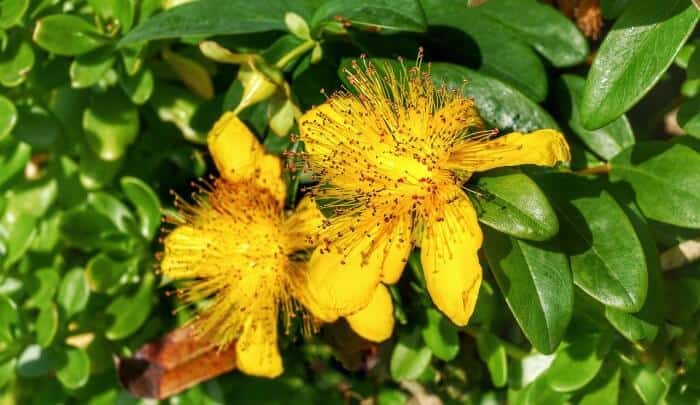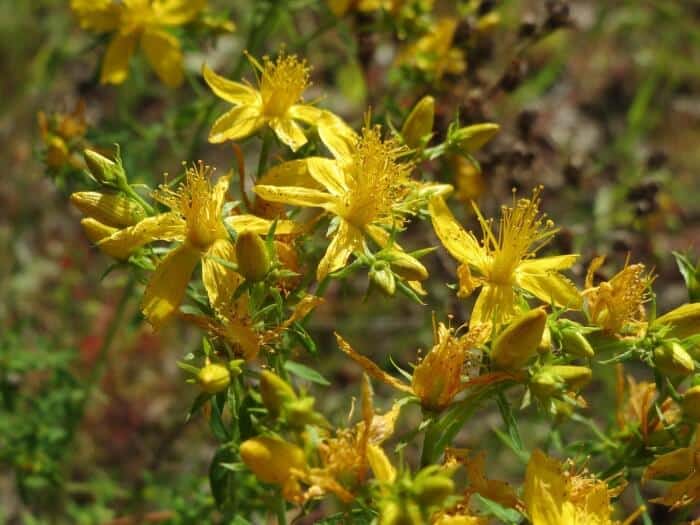St. John’s wort is both a mysterious and debated member of the herb family. You’ve heard of it, but what is it really?
Is it a noxious weed or a miraculous medicinal plant? Poisonous to your livestock or not? A vitamin supplement or a disaster for your homestead or ranch?
In this article, we’ll talk about the benefits of St. John’s wort, how to grow and harvest it, and some of its shortcomings, too.
What is St. John’s wort?
St. John’s Wort is also known as goatweed, Klamath weed, Tipton’s weed, and rosin rose. In latin, it is Hypericum perforatum. St. John’s wort is named after John the Baptist, because the flowers are harvested on June 24th, the day of St. John the Baptist’s birthday feast.
Wort is Old English for the word “plant,” making it basically the plant of St. John the Baptist. It grows wild in fields and meadows but has also been cultivated as a garden plant.
This perennial herb grows about one to two feet across and one to three feet high. It produces small, cheery yellow flowers on a yellowish-green shrub. St. John’s Wort spreads easily, and a single plant can produce up to 100,000 seeds per year. Those seeds can be viable for up to ten years.

What is St. John’s Wort known for?
St. John’s wort has been used in traditional medicine for centuries to treat nerve disorders as well as mental health issues.
According to healthline.com, there is evidence that the supplement, which is not regulated by the FDA for these claims, is as effective as medication for treating mild to moderate depression.
St. John’s wort has fewer side effects than medication for depression. It also has sedating properties and is said to improve a variety of health issues such as PMS, Seasonal Affective Disorder, and promotes better healing for wound care.
It is one of the most commonly purchased health supplements in the United States. You can purchase St John’s wort supplements in pill form, essential oil, or you can grow the plants and use the fresh flowers, leaves, and stems yourself.
St. John’s wort does have some side effects. These side effects could include things like restlessness, irritability, photosensitivity, and an upset stomach.
Also, it may interact with prescription medications, such as birth control pills, depression medication, and other important medications. In spite of the side effects, you and your health care team may decide this is a good supplement for you.
Aside from the medical reasons, there are plenty of others to plant St. John’s Wort. This hardy perennial makes an attractive ground cover with its low green shrubbery and cheery yellow flowers that bloom from mid-summer and into the fall, when berries begin to form.
Its root system makes it useful in places where soil erosion is a problem, such as riverbanks. St. John’s wort will self-seed and spread easily. It is easy to care for and thrives under a variety of conditions, including poor soil.
Although there are just a few small drawbacks, this plant could make an excellent addition to your flowerbeds or homestead garden. Here is how to grow it.
Where to plant St. John’s Wort?
St. John’s wort can be invasive, so take great care where you plant it. It can easily get out of hand and choke out other beneficial plants and flowers. You probably don’t want this herb running crazy in your yard.
You may want to keep its growth constricted to containers, or at least plant it where it will be naturally contained by rocky borders, raised beds, or anywhere its tendency to spread won’t choke out other plants.
You may want to plant it somewhere out of the way, such as the outskirts of your property, as it does not have a sweet flower smell. St. John’s wort does not need frequent care, so it only needs to be as accessible for when you want to prune or harvest it.
How much sun does it need?
St. John’s wort grows best in a combination of morning sunshine and afternoon shade. Too much afternoon sun will scorch the tender leaves, although too little sun will leave the plant with few flowers. Partial shade is just right for these pretty plants.
How much water does St. John’s wort need?
St. John’s wort is very adaptable when it comes to watering and how much watering the plant needs. It does well in moist soil, but it can easily adapt to drier soils as well, especially once it is well established.
Adult plants can typically survive both droughts and floods. Young plants need consistent moisture until they are well established.
A little watering during droughts will go a long way to keep the plants healthy, however, take care not to overwater as the plants will not grow well with constant overwatering.
Plants grown in containers may need more frequent watering than plants grown in your garden. A light layer of mulch can help keep moisture in.
Growing Zones
St. John’s wort can be grown anywhere from zones 5 or 6 to zones 9 or 10. If you live anywhere within these zones, you should be able to successfully grow this hardy and adaptable plant.
Soil Types
This plant isn’t too fussy when it comes to soil types. It will grow nicely in somewhat acidic and somewhat alkaline soils. It will grow in sandy, loamy, clay, or even rocky soil. You can improve your soil by mixing in some compost when you plant your seeds or plants.
How to Plant St. John’s Wort Seeds
St. John’s wort seeds can be started indoors six to eight weeks before the last frost date. While the seeds will start well indoors, the plant itself will not grow well indoors and would do much better outside. Gently press your seeds into the soil, but do not cover them up. These seeds will germinate better with the light.
You can direct sow the tiny seeds in your garden by surfacing sowing so the sunlight can help them germinate. Surface sowing means to lightly press the seeds into the soil without covering them up completely.
Do not sow seeds until after all danger of frost has passed. If desired, the seeds can be soaked in warm water for a few hours or overnight to get a head start on germination. Germination typically takes two to four weeks.
Propagating with Cuttings
You can also propagate St. John’s wort with cuttings from the plant. Simply choose a healthy stem and cut off a portion of stem that is about two to four inches long. Remove the leaves from the bottom half. Dip in root growth hormone if possible.
Place the bottom half to the stem in soil and keep it moist until roots begin to grow. The cuttings will do well with some sun but be careful not to scorch them.
In early spring, when plants are just beginning to grow, you can propagate St. John’s wort by root division. Dig up the entire plant and split in half. Then carefully replant it where you would like more plants to grow.
How to Plant St. John’s Wort Plants
Once your started plants have reached at least two inches high, or your cuttings have grown roots, or you have purchased your plants, you’ll be ready to put them in the garden.
Apply several inches of compost, especially if your soil is poor, then turn the soil about eight inches deep.
Plant each plant two to three feet apart, and deep enough to match the level of soil on the stem. Water deeply and thoroughly without overwatering, so the plants can get acclimated.
Once the plants are established, they will need less frequent watering. Fertilizer is only needed for very poor soils.
While St. John’s wort doesn’t need a lot of fertilizer it does benefit from some compost. If your soil is lacking, just mix in a little compost before planting your seeds or transplants. This will help the plants get a hearty start.
Pruning St. John’s Wort
St. John’s wort can easily get out of hand. If you are not harvesting this perennial regularly. You will probably want to prune it at least every other year to keep it under control.
Remove any dead or damaged branches, and you may want to remove some of the other branches to provide better airflow between the plants. Prune off 1/3 of the height of each bush.
St. John’s wort will grow flowers only on the new growth. This means that pruning should be done in early spring, such as mid to late March, in order to promote rather than discourage flower growth.
When a branch is cut, it will split into two stems, which will become two clusters of flowers. If necessary, you can prune St. John’s wort almost completely down to nothing to give it a chance to be completely rejunevated.
How to Harvest St. John’s Wort
St. John’s wort should be allowed to flower before it is harvested, typically in early summer. Other herbs taste better when they are harvested before flowering, such as mint plants, but St. John’s wort is more effective after it has flowered.
The plant can easily be harvested by cutting the flowers, stalks, and leaves from the plant. Approximately 1/3 of the plant can be safely harvested at a time without damaging the plant.
How to Store It
Dry your cuttings by hanging them upside-down with leaves and stems attached. Keep them in a cool, dark place for a week to ten days until they are dried.
You could also dry cuttings in a commercial dehydrator, or in a warm oven spread over a cookie sheet at about 100 degrees Fahrenheit.
Store dried St. John’s wort in an airtight container in a cool, dark area and use it for teas, tinctures, and oils.
Pests and Diseases
There are few pests are diseases that affect this hardy perennial. One common pest is the Klamath beetle which feeds on the plant.
The other common pest is a fungal disease, known as anthracnose, which presents as rust spots on stems and leaves. You can remove infected plants individually or spray with an insecticide or fungicide.
Pitfall’s to Growing St. John’s Wort
The biggest deterrent to growing your own St. John’s wort is in its ability to spread. It spreads via seeds as well as underground runners. This hardy plant is difficult to kill and can choke out other plants.
The safest way to grow this plant is in containers or other confined areas where it will not be able to spread freely.
Because it has overtaken pasture land and meadows, in some states, this plant has been deemed a noxious weed. In spite of its benefits, there may be laws against planting this plant in your town.
Another pitfall to St. John’s wort is the odor it releases. It does not give off a pleasant, flowery smell, rather an unpleasant one. If passersby brush the plant, the fumes could be a nuisance. You may want to plant this perennial away from your home so as not to smell it.
Can Livestock Eat St. John’s Wort?
There are varying beliefs about the effects of St. John’s wort on pets and livestock. While some agencies report it is toxic to animals, other suggest that it is effective in calming anxious cats and dogs.
If you think your dog or cat is experiencing anxiety, speak with your vet about whether this the best treatment option for them. The main issue caused by St. John’s wort seems to be photosensitivity in animals with light fur and light skin. Animals with dense and dark fur seem to be unaffected by this issue.
Home Remedies Made from St. John’s Wort
There are a number of home remedies that can be made from St. John’s wort. We are not doctors or health professionals, and this information is only given to educate you on what others have done with St. John’s wort.
Please do your research and discuss it with your medical health practitioner before using any of these suggestions.
According to eclecticherb.com, you can make first aid oil, tinctures, tea, and salve from fresh St. John’s wort plants.
- Oil. The oil is made by steeping leaves in olive oil for a month. After the oi is strained, you can use it for bruises or other topical skin conditions.
- Salve. Salve is made by combining the oil and beeswax.
- Tinctures. Tinctures are made using vodka and fresh flowers.
- Tea. Teas are made by steeping the leaves and flowers in boiling water.
How to Make St. John’s Wort Tea
One means of taking this herb is in a tea. This tea is easy to make and enjoy, and is traditionally taken for its sedating, calming, and anti-depressant properties.
However, this herb can have side-effects such as photo-sensitivity. It can also interfere with a number of other medications, including birth control. Contact your doctor or pharmacist for more information before ingesting this herb.
The tea can be made with both the leaves and flowers that grow on the St. Johns wort plant.
Pour one cup of boiling water over 2 teaspoons of the leaves and flowers and allow the tea to steep for five to ten minutes. Strain your tea through a coffee filter.
St. John’s wort tea has a bitter taste, you may want to sweeten it with honey or sugar. You may want to blend your tea with other herbs such as lavender or chamomile.
Related Plants
St. John’s wort, or hypericum perforatum, is the form you purchase as supplements at the health food store. Although it has many wonderful uses, it does spread quickly and become out of control.
However, if you are looking to grow ground cover and aren’t concerned with the health benefits of hypericum perforatum, then you may want to try one of these other varieties. There are several ornamental cultivars that are similar to St. John’s wort but are less likely to grow wild.

- Creeping St. John’s Wort. For example, Creeping St. John’s wort, Hypericum calycinum, is related to Hypericum perforatum but it does not have the medicinal benefits. However, it makes a wonderful ground cover that is less invasive that Hypericum perforatum.
- Tricolor. H. x moserianum or ‘Tricolor’ boasts variegated foliage and a range of colors including pink, cream and green.
- Sunburst. H. frondosum, or ‘Sunburst, ’is more cold-weather hardy than other cultivars.
There are many medical and practical reasons to grow St. John’s wort in your garden or on your homestead. Because of its root system, it makes a great ground cover that is highly effective where soil erosion is present.
It is pretty and cheerful to look at. St. John’s wort has religious meaning because of John the Baptist’s birthday. It also has some potential benefits to our wellbeing.
With a little caution and planning, this herb will make a great addition to your homestead and garden.


Amanda is a homesteader and a Jesus-loving, mother of 6 toddlers. She’s raising lots of fancy chickens and goats on her small homestead (among other things). Find out more about the team here.

Just planted two St John’s Wort bushes two weeks ago watering them a little bit twice a day one of the plants is doing fine in partial shade the other one has more sun and I’m wondering why the inner leaves are turning brown thank you for an answer. Gretchen